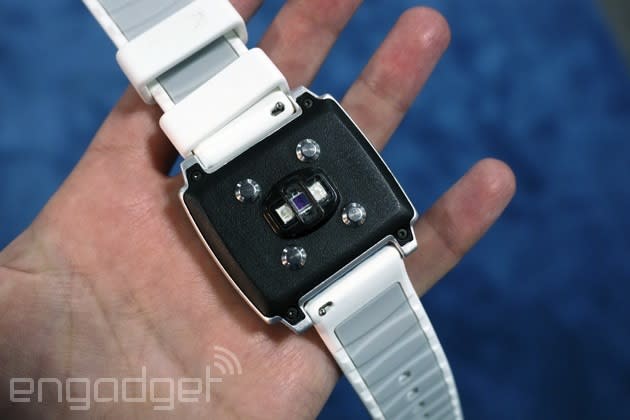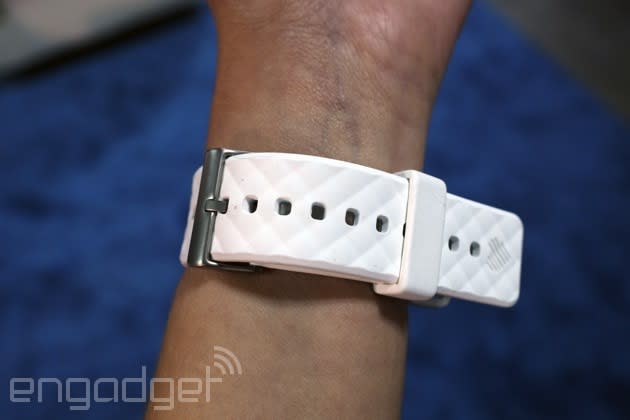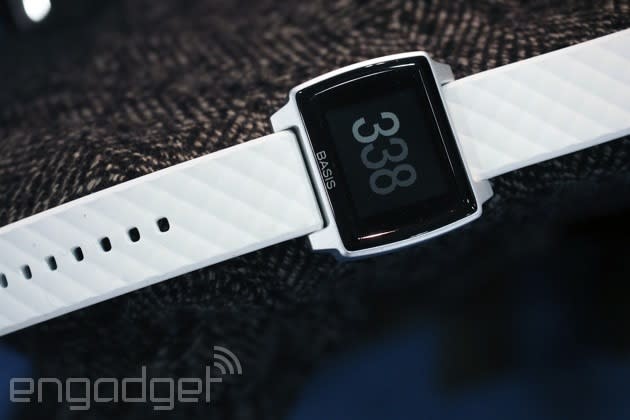Basis Peak review: a good fitness tracker, with room to be a good smartwatch

Jawbone. Fitbit. Microsoft. And now... Basis. If you don't know much about the brand, you really should get up to speed: The company quietly put out one of the best fitness trackers, and now it's a part of Intel. Which means, it's officially one of the big names in health gadgets. Like the previous-generation B1 band, the new Basis Peak can automatically detect when you're exercising or asleep, making it one of the most automated fitness trackers around. This time, though, it brings a sharper design, a redesigned app and an improved sensor that can track your heart rate when you're working out, as opposed to when you're just sitting still. What's more, it will eventually be able to display smartwatch-like notifications on its 1.25-inch touchscreen, at which point it'll be way more versatile than your typical fitness band. Like before, the Peak costs $200, meaning it's still one of the more expensive fitness trackers on the market. As you'll see, though, I'm not sure that's a dealbreaker.
Hardware

This is where every review takes a subjective turn. Personally, I think the Peak is a good-looking piece of kit. That said, as I was testing it, several of my Engadget coworkers made offhand remarks about how ugly the thing is. It all depends on your taste, I suppose. That, and how you classify the product to begin with. As a fitness tracker, the Peak is a big, clunky thing. It calls way too much attention to itself. Which is to say, it looks more like a smartwatch, what with its 1.25-inch screen and 23mm wristband. And as a smartwatch, well, it ain't bad. Its black-and-gray monochrome display is actually dainty compared to some of the big-screen models we've seen, like the LG G Watch R, Moto 360 and Samsung Gear S. As a woman with a bony wrist, I worry the Peak might be a little too much for me. It doesn't go with all my outfits either, which doesn't help. Still, as far as smartwatches go, this is one of the more discreet options. And hey, if you're a guy with thicker bone structure and a more masculine wardrobe, well, none of this might even apply to you. I'm willing to bet a dude in a button-down looks better in this watch than I do in a blouse and skirt.
Regardless of what you think of the design, though, I think we can agree on this: It's a clear improvement over Basis' last-generation fitness band, the B1. First off, the metal body is thinner, so the whole thing just looks a bit sleeker. Also, that touchscreen is actually new. Without that in the last model, you instead had to tap these small screw-like pins stuck in the four corners of the display. It was unsightly, and also made the watch kind of tedious to use. The touchscreen here is much sleeker, and also easier to operate. Then there's the band. Whereas it used to be made of hard plastic, it's now fashioned out of soft silicone, available in black and white. On the black model in particular, the weave pattern could be mistaken for matte-finish metal from afar -- kind of like on the Pebble Steel. (On the white model that I tested? Not so much.) Anyway, if you're not as enamored with the band as I am (it's comfy, guys!) you can replace it with any standard 23mm band of your choosing.

On the underbelly of the watch face you'll find a new optical heart rate sensor, which glows green when in use (much more on this later). There's also a set of charging pins that allow it to fit inside the proprietary charging cradle. Speaking of the sort, the Peak is rated for four days of battery life, which seems about right to me -- I only ended up charging it twice a week or so. Not great for a fitness tracker, but excellent for a smartwatch, which this essentially is -- or will be.
Under the hood, there's now a Bluetooth LE radio, similar to what you'll find in basically every other new smartwatch and fitness band. Also like some other devices, the Peak is water-resistant in up to 50 meters of pressure -- a rating known as "5 ATM." So, you can safely swim and shower with it, but you'll want to be careful about surfing or any other water sport where wipeouts are possible. Of course, too, that's with the standard silicone band -- it holds up well after being submerged in water. If you swap in your own 23mm wristband, though, your mileage is going to vary.
Getting started

Like other fitness bands we've tested recently, the Peak is only compatible with a handful of devices, though it's worth noting that the selection here is especially small. As of this writing, Basis officially supports just five Android phones: the Nexus 5, HTC One M8 and the Samsung Galaxy S4, S5 and Note 3. Compare that with Garmin, whose new Vivosmart band works with 10 different Android phones. It's a frustrating situation either way, but more is definitely better here.
Unofficially, the Peak should work with any Android phone running Android 4.4.2 or higher, with a screen between three and six inches. That's all theoretical, though: In my tests, the Peak would only pair with devices on the official support list. Anyhow, Basis says it will add support for more handsets over time. And if you own a reasonably new iPhone, you're already set: The Peak is compatible with the 4s and up, as well as the fifth-gen iPod touch.
Assuming you're in possession of an officially supported phone, the setup process is quick and easy. Just install the iOS or Android app, and either create a new account or sign in with your existing one. Then plug the watch into your computer's USB port using the proprietary cradle, and hit the pair button from inside the app. At that point, the two devices should start talking to each other, and the setup process should just complete itself; at no point do you have to put the watch into pairing mode, or anything like that. And there you have it. Now you're ready to put on the watch and get moving.
In use

What's always made Basis bands special is how little work they entail. Thanks to an arsenal of different sensors, the watch knows when you're exercising and when you've gone to sleep; you never have to enter a specific mode in order for it to work properly. But even though these features aren't new on the Peak, I still think they're worth celebrating. When I started a workout on the elliptical machine, the watch took just four seconds to catch on. And when I look at my sleep report in the morning, my supposed bedtime always matches up closely with the time I saw on the clock right before closing my eyes. Basis' bands aren't the prettiest, but they're the only fitness trackers I've been able to wear with any consistency. That's because the hardware isn't asking me to do very much, other than wear it.
"So why not just buy the original B1 band on sale?" you're asking now. "It has all the same core features, doesn't it?" In fact, the Peak is indeed a little smarter than its predecessor. Whereas the original could only detect your heart rate if you were sitting still, or engaged in light activity, like walking, the new model can track your heart rate even if you're in the middle of a rigorous workout. Though this might seem like a no-brainer feature, it actually took a fair amount of R&D before Basis could figure it out. The problem is that the original B1 used an optical heart rate sensor that produced a lot of signal noise during workouts. Meanwhile, an electrical sensor like the kind used in chest straps would have meant chunkier hardware and shorter battery life.

At last, though, the company landed on a new optical sensor, one it says is more accurate. I'd say it works as advertised. During an elliptical workout, I periodically checked my heart rate using both the Peak and the elliptical's built-in sensor, and every time the readouts were either identical or very similar -- there was never more than a three-point difference. All told, the heart rate sensor captures your heart rate up to 32 times per second, according to a company spokesperson, which helps explain why my readings were so accurate, especially during steady-state workouts where my pace didn't fluctuate much.
Keep in mind, though, that if you're doing an activity where your heart rate increases or decreases rapidly, it could take the watch up to 10 seconds for the device to calculate your heart rate. The reason for that lag: the same algorithm that's designed to cut down on signal noise. It means the watch sometimes needs a few extra seconds to think. Even then, you're not likely to notice. Basis says that in the event of a lag, the readout will be delayed; you won't see the reading drop out, and the watch won't hang on the last-known number either. Basically, then, you'd also have to be wearing another heart rate tracker to know for sure whether the heart rate reading was in real time or it was slightly delayed. And if it was a few seconds off, would you even care? I don't think I would.
To those of you who still think the Peak is but a modest upgrade over the original B1, I'd also encourage you to consider the touchscreen. Not only does the watch look more streamlined without any pins around the display, but it's also significantly easier to use. All I have to do is swipe from left to right to see my settings, heart rate and step count. Because the watch lacks a GPS radio, it doesn't track distance, which is a bummer. Basis has said that it left out that part to conserve battery life, and that it assumes people will be using a smartphone for sports apps anyway. That may be true for some people, but not all of us like to work out with a phone on our person. Personally, too, if I'm going to go out of my way to wear a fitness tracker, I'd like for it to display as many of these "high-level" stats as possible. Calories and steps taken are a good start, but I'd expect to know my daily mileage too.
At any time, I can swipe up on the watch face to see my daily activity totals. Really, it's not that different from an Android Wear watch, where you're mostly swiping left and right, or up and down. That's important because the Peak will one day be a smartwatch in its own right: At some point before 2014 is up, Basis will push out a software update that brings notifications for things like voice calls. When the time comes, users will want to sift through that information quickly and easily. The UI here creates a good blueprint for that.
App

Really, except for when I take the watch off to charge it or swipe the touchscreen to peek at my step count, I barely interact with the hardware itself. I just leave it on my wrist, and am sometimes able to forget it's even there. If anything, I've been spending more of my time in the app. And what a nice app it is. To be clear, this is a totally separate application from what the older B1 used, with a slicker design and more intuitive UI. This time around, you can see more information on the main home screen, including your heart rate, step count and calorie burn, along with an activity feed showing things like recent workouts and last night's sleep stats (deep sleep vs. REM sleep, for example). Everything is color-coded, so I know at a glance if I've met my goals (green) or if they're in progress (yellow). Anything heart-related appears in red, which also makes sense.
Of course, you can also drill down and get even more detail. With sleep, for example, you can see how much deep, REM and light sleep you got, how many "interruptions" you had and how many times you tossed and turned. When it comes to things like deep sleep, you can see both what percentage of your sleep that included, as well as how much time you spent in each of these sleep stages. What to do with all this information? There's a chart breaking all this down, along with an overall sleep score (34 percent, for example, if you only get 2.5 hours of REM sleep and two hours of deep sleep). Even so, I could use some more insight into what these stats actually mean. Basis could do a better job of not only explaining that, but also offering me personalized advice on what I could be doing better.
As before, too, Basis lets you sign up for challenges -- or "habits," to use the company's word. Personally, I signed up for "Move it" (be active for 30 minutes, three days a week) and "Morning Lap" (take 2,000 steps before noon). Oh, and I also signed up for "Wear it," where I get credit just for using the thing. (I never did say I was an overachiever.) There are also options for "Evening lap," having a regular bedtime and wake time, getting up to walk around every hour, and so on. I think you get the idea.
From the home screen, I can see my habits and which ones I've fulfilled -- you can tell you're doing a good job because they start to glow green as you tick off your various goals. There's also a dedicated "habits" page within the app where I can get more information -- say, how long I "wore it" each day, or how much active time I banked each day to win the "Move it" challenge. In the beginning, you can only sign up for three habits, but over time, as you consistently practice good habits, you earn the right to add more. Between that and the encouraging green color-coding, I feel like I'm being rewarded for good behavior, and I feel motivated to keep up my winning streak.
The competition

Basis has lots of competition, both among fitness bands and smartwatches. That said, for all the options we have right now, no one seems to be getting this fitness-tracking thing exactly right. Because the Peak can automatically detect when you're working out or have gone to sleep, it's more technologically advanced than most other fitness trackers, including the Fitbit Charge ($130), Microsoft Band ($200), Garmin Vivosmart ($170) and the Jawbone Up24 ($130). (In fairness: The forthcoming Up3 will have workout detection, but it's not out yet. The Microsoft Band will eventually get sleep detection too, through a future software update.) The Peak is also more sophisticated than your typical smartwatch -- most of them can't even deliver an accurate heart rate reading, much less tell when you're exercising or sleeping. And remember that the Peak will soon deliver notifications too, just like a smartwatch.
I would caution, however, that it's still not as sleek as a standalone fitness band, or even some smartwatches, like the Moto 360. And again, while the app is a big improvement over the old one, I've seen software from other companies that's even more polished, both in terms of UI as well as their ability to motivate users to live a healthier life. Jawbone, in particular, places a big emphasis on delivering insights into how the body works -- reminding you, for instance, that you crave more carbs when you're sleep deprived. Microsoft, meanwhile, seems to have a winner with Microsoft Health, even if its inaugural Band feels unfinished from a hardware standpoint. All that said, the Peak's few shortcomings are outweighed by its strengths. It's not perfect, but it stands as one of the best fitness trackers you can buy. Maybe one day it will also be one of the best smartwatches. But hey, first things first.
Wrap-up

Despite its relatively high price (and a few imperfections), the Basis Peak is still one of the best fitness trackers you can buy right now. That's mostly because of how automated it is, with the ability to track your sleep and workouts without you having to enter any sort of special mode. A few other fitness trackers can do that for exercise or sleep, but usually not both. It's also on the cusp of receiving a software update that will make it behave more like a smartwatch, with notifications for things like texts. And guess what? When that time comes, the Peak is likely to have longer battery life than just about any other smartwatch we've tested so far.
Again, though, there are some trade-offs. While the app has seen huge improvements, it still doesn't offer as many insights as, say, Jawbone's. It doesn't track distance, which feels like a silly omission. The device is bigger than competing fitness trackers, but that'll matter less once the Peak gets those smartphone notifications -- if it acts like a smartwatch, then it's OK if it looks like one too. On that note, it probably makes sense to hold off on buying the Peak until that software update comes through; without it, you're not using the device to its full potential. Also, as you can imagine, we'd rather see if the notifications work as advertised. In any case, though, if you insist on buying a fitness tracker now, the Peak is indeed a good choice. A pricey choice, but a good choice nonetheless.




































